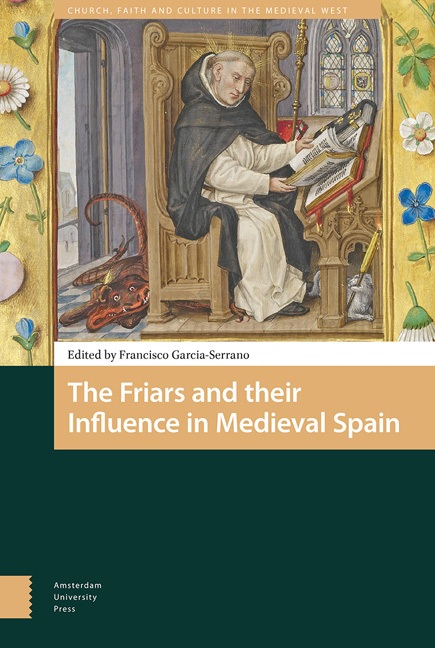Book contents
- Frontmatter
- Contents
- Abbreviations
- List of Illustrations
- Acknowledgements
- Introduction
- 1 Dominicus Hispanus
- 2 Ramon de Penyafort and His Influence
- 3 The Mendicant Orders and the Castilian Monarchy in the Reign of Ferdinand III
- 4 Ramon Marti, the Trinity, and the Limits of Dominican Mission
- 5 Narrative and Counter-Narrative: Dominican and Muslim Preaching in Medieval Iberia
- 6 The Poor Clares of Alcocer and the Castilian Crown (Thirteenth to Fifteenth Centuries)
- 7 Friars and Nuns: Dominican Economy and Religious Identity in Medieval Castile
- 8 Networks of Dissent and the Franciscans of the Crown of Aragon
- 9 Faction, Politics, and Dominican Inquisitors in the Fourteenth-Century Crown of Aragon
- 10 Sutzura e Viltat Carnal: The Place of Sin and Lust in the Treatises of the Franciscan Francesc Eiximenis (c.1400)
- 11 Valencian Dominicans Beyond the Convent of Santo Domingo
- 12 Ferdinand of Antequera and Santo Domingo el Real de Toledo: Patronage, Advice, and Spiritual Favour (c.1390–1416)
- Index
9 - Faction, Politics, and Dominican Inquisitors in the Fourteenth-Century Crown of Aragon
Published online by Cambridge University Press: 16 February 2021
- Frontmatter
- Contents
- Abbreviations
- List of Illustrations
- Acknowledgements
- Introduction
- 1 Dominicus Hispanus
- 2 Ramon de Penyafort and His Influence
- 3 The Mendicant Orders and the Castilian Monarchy in the Reign of Ferdinand III
- 4 Ramon Marti, the Trinity, and the Limits of Dominican Mission
- 5 Narrative and Counter-Narrative: Dominican and Muslim Preaching in Medieval Iberia
- 6 The Poor Clares of Alcocer and the Castilian Crown (Thirteenth to Fifteenth Centuries)
- 7 Friars and Nuns: Dominican Economy and Religious Identity in Medieval Castile
- 8 Networks of Dissent and the Franciscans of the Crown of Aragon
- 9 Faction, Politics, and Dominican Inquisitors in the Fourteenth-Century Crown of Aragon
- 10 Sutzura e Viltat Carnal: The Place of Sin and Lust in the Treatises of the Franciscan Francesc Eiximenis (c.1400)
- 11 Valencian Dominicans Beyond the Convent of Santo Domingo
- 12 Ferdinand of Antequera and Santo Domingo el Real de Toledo: Patronage, Advice, and Spiritual Favour (c.1390–1416)
- Index
Summary
Abstract
Thanks to the Directorium inquisitorum, Nicolau Eimeric has become something of a model inquisitor. Yet his self-presentation as a relentless prosecutor of heresy obscures a more complicated historical reality. Friars serving as heresy inquisitors (including Eimeric) often found themselves limited by political circumstances. These included factional clashes within the Dominican Order itself, as well as the impositions of bishops, popes, and kings. By examining the friars’ social networks and how various inquisitors were affected by contemporary events – from reforming efforts and schism to intrigues surrounding the conquest of Mallorca—this chapter suggests that heresy prosecutions waxed and waned over the course of the fourteenth century, depending on the character and connections of individual inquisitors.
Keywords: Dominicans, medieval Aragon, medieval inquisition, Nicolau Eimeric, Mallorca
On 16 August 1341, as he entered the bishop of Barcelona's imposing stone palace to sign yet another arrest warrant, the Dominican inquisitor Bernat de Puigcercós gave every appearance of being a very powerful man indeed. With nearly a half century of service in the order to his credit, he had already achieved a great deal, and showed no indication of wanting to slow down any time soon. He was known in the most exalted of secular circles, both comital and royal, throughout his native Catalonia. Benefiting from an impressive elite education, including a stint of higher theological studies at Paris, he had taught in some of the Aragonese province's leading convent schools. He had been a conventual prior and a provincial vicar in that same province, before ruling as provincial prior of Aragon for nearly a decade (1324–1333), longer than any previous incumbent. He was a prolific writer whose opinions were valued on everything from apocalyptic speculation to the finer points of high finance and economics. He had also served for many years as a papally appointed inquisitor, and the weight of his verdicts had fallen heavily on Beghards and Judaizers alike. And now, on this late summer day, the venerable inquisitor's attention was focused on a Jew named David de Ripoll – accused of abducting his own daughter and granddaughters to prevent their forcible baptism at the hands of a converted son-in-law. Given both his previous track record and his current eagerness to prosecute members of the Jewish community, this did not bode well for the accused.
- Type
- Chapter
- Information
- The Friars and their Influence in Medieval Spain , pp. 191 - 220Publisher: Amsterdam University PressPrint publication year: 2018

